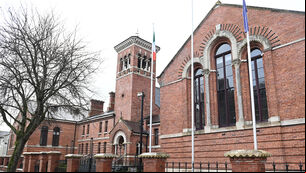New report recommends major overhaul of Cork city's fire service

The report phase one goals to be implemented over the next one to three years include the development of the new full-time station in the south-western suburbs, closer to the city centre than Ballincollig.
At least two new fire stations in Cork city are needed by 2035, according to a new review, which has identified issues with two of the three current stations.
Key findings of the Cork City Fire Cover Review report, which was published today, include the necessity for a new full-time fire station in the south-west of the city, which should be developed in the next three years as part of a three phased plan.
The review was commissioned in response to the Strategic Review carried of the Cork City Fire and Building Control Department following the city’s 2019 boundary extension, taking into future projected population growth.
Cork city grew fivefold and the population increased from 125,000 to 210,000 under the boundary extension. The city is also forecast to see a rise in population to 350,000 by 2040, meaning expanded fire services are required.
Crowe Ireland, ed by a specialist UK spatial data and consultancy company Cadcorp, were tasked to analyse a wide range of data and to model how best fire cover can be provided.
The resulting review shows that the current response times from Ballincollig to major centres of potential high risk - including Cork University Hospital, University Collage Cork, Munster Technological University, and other significant industrial and commercial businesses - are “suboptimal”.
The report said a new fire station in the south-western suburbs, adjacent to the N40 South Ring Road and potentially located between Ballincollig and Bishopstown, “would provide much quicker response times to these high-risk centres”, with the review noting that the establishment of this station would also improve service response times in Ballincollig.
The report phase one goals to be implemented over the next one to three years include the development of the new full-time station in the south-western suburbs, closer to the city centre than Ballincollig.
Cork City Council has confirmed that a funding application will be submitted “for the immediate implementation of the phase one recommendations to the National Directorate for Fire and Emergency Management”.
Rather than being an additional fire station, this would likely be a replacement, as the report says that the present retained station at Ballincollig “is not considered to be a suitable location due to its configuration, its limited expansion potential, and its distance from the city”.
It recommends that over the next three years, "future uses of the Ballincollig service should be considered with a view to repurposing it as a local and regional training, operational and logistics facility”.
Under phase two, over the following four to seven years, the new station in the south-western suburbs could considered as the future location for the headquarters for the Cork City Council Fire and Building Control Department, and the base for specialist equipment and other operational resources relocated from Anglesea Street.
Also contained in phase two is the identification of two new or reconfigured station locations, one in the city centre – which might potentially be at Anglesea Street, subject to review – and the other at a new location in the north-west.
A review into the future uses of the Anglesea Street should take place during this phase, including redevelopment or the potential for the cessation of operational response services from this location and their relocation to a new location in or near the city centre.
The report explains:
It identifies that most of the Cork City Fire Brigade specialist fleet is located there, and the building provides office accommodation for operational staff and for other sections including building control, fire prevention, and istration.
“Whilst there may be a significant opportunity for Cork City Council to sell this property and relocate all resources based at Anglesea Street to other locations across the city, there is a strong case for retaining some fire cover in the city centre," reads the report.
If a smaller station were to be located in the city centre, office accommodation for other sections could be relocated elsewhere and training facilities could be considered for relocation to Ballincollig.
Following the review of Anglesea Street, the best option identified should be put into place in the next eight to 10 years during phase three, with the other new station in the north-western suburbs also to become fully operational during this period.
The report concludes: “It is likely that Cork City Council will need to make a significant investment in the development of its fire service physical building infrastructure in the coming years, including both construction of new stations and refurbishment of existing locations”.
It noted the council’s commitment that a funding application will be submitted for the implementation of phase one.
The report has been welcomed by the fire service, with chief fire officer David Spillett saying he is particularly pleased that the report highlights the need for additional stations and infrastructure, "which will enhance fire service cover and our response capability across the entire city."
Brian Geaney, the council’s assistant chief executive and chairperson of the Fire Review Steering Group, also welcomed the conclusion of the review
“This report marks an important step in the process of modernising the City Council Fire and Emergency response Service to future proof same," said Mr Geaney.
“Its findings are designed to ensure that these critical services remain equipped to safeguard lives and adapt to evolving risks in an ever-changing landscape.”
The council’s director of emergency management and climate action, David Joyce, said that the detailed report sets out a clear roap for the future.
“This report represents the culmination of a significant quantum of analysis, both spatial and statistical," said Mr Joyce.
“This resulting Fire Cover Review report clearly lays out a future development strategy which details the infrastructure investments which need to be delivered in Cork city to meet the expanding needs of our growing city, it’s communities and businesses.”







 App?
App?


